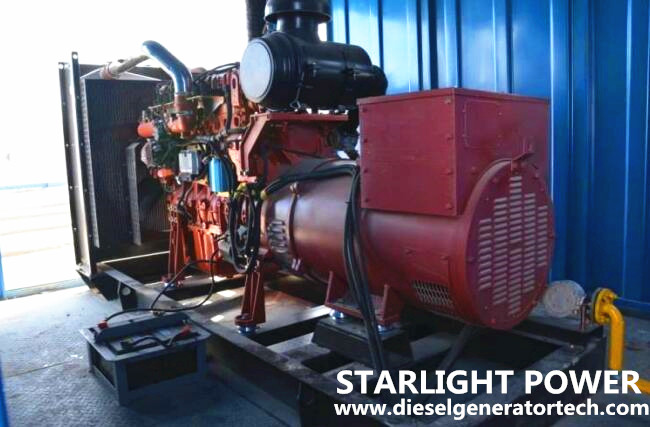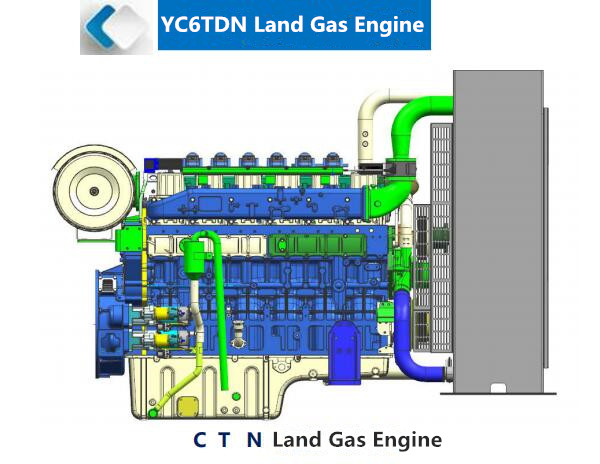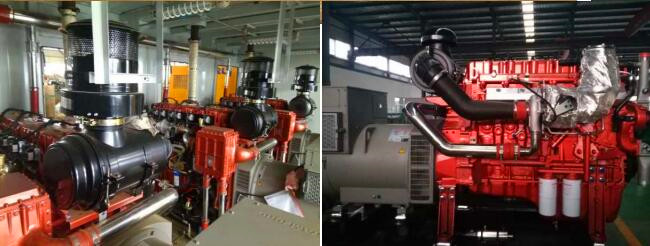We have introduced a part of Yuchai power generator gas engine models and its technical characteristics in previous article. In this post, you will not only learn other model parameters of Yuchai gas engine, but also learn the maintenance methods for gas generating sets. If you are interested, why not take a few minutes to read on?
YC6KN Series Power Generation Main Technical Parameters
Model | YC6KN |
Rated Power / Speed (KW/rpm) | 200 - 281/1500 (Gas) |
Standby Power / Speed (KW/rpm) | 220 - 309/1500 (Gas) |
Type | 4 Stroke, water cooling |
Cylinder arrangement mode | In-line |
Aspiration | Turbocharged |
Control system | Premixing before pressurization |
Single point injection after supercharging | |
Valve number | 4 |
Cylinder-Bore x Stroke (mm) | 6-129 x 165 |
Displacement (L) | 12.94 |
Intake pressure of gas system (kPa) | Low – pressure: 0 - 0.2; |
Medium-pressure: 400 – 600; | |
Fuel | Natural gas (Mid-pressure) |
Natural gas, biogas, associated gas (Low-pressure) | |
Minimum gas consumption rate (g/kWh) | ≤191 |
Oil consumption rate (g/kWh) | ≤0.2 |
Firing order | 1-5-3-6-2-4 |
Crankshaft rotation direction | Anticlockwise |
Starting method | Electric start |
Oil capacity (L) | 32 |
Emission level | Non-road T3 |
Flywheel interface dimensions | SAE 14” |
Flywheel shell interface dimensions | SAE 1# |
Overall dimensions (mm) | 1870 x 970 x 1457 |
Weight (kg) | 1275 |
Genset power (KW) | Common: 150-250 |

YC6TN Series Power Generation Main Technical Parameters
Model | YC6TN |
Rated Power / Speed (KW/rpm) | 250 - 300/1500 (Gas) |
Standby Power / Speed (KW/rpm) | 275 - 330/1500 (Gas) |
Type | 4 Stroke, water cooling |
Cylinder arrangement mode | In-line |
Aspiration | Turbocharged |
Control system | Premixing before pressurization |
Valve number | 4 |
Cylinder-Bore x Stroke (mm) | 6-145 x 165 |
Displacement (L) | 16.35 |
Intake pressure of gas system (kPa) | Low - pressure: 0 - 5; |
Fuel | Natural gas, biogas, oil field gas, etc |
Minimum gas consumption rate (g/kWh) | ≤185 |
Oil consumption rate (g/kWh) | ≤0.5 |
Firing order | 1-5-3-6-2-4 |
Crankshaft rotation direction | Anticlockwise |
Starting method | Electric start |
Oil capacity (L) | 52 |
Emission level | Non-road T3 |
Flywheel interface dimensions | SAE 14” |
Flywheel shell interface dimensions | SAE 1# |
Overall dimensions (mm) | 1909 x 1137 x 1641 |
Weight (kg) | 1980 |
Genset power (KW) | Common: 200 - 250 |
YC6TDN Series Power Generation Main Technical Parameters
Model | YC6TDN |
Rated Power / Speed (KW/rpm) | 300 - 400/1500 (Gas) |
Standby Power / Speed (KW/rpm) | 330 - 440/1500 (Gas) |
Type | 4 Stroke, water cooling |
Cylinder arrangement mode | In-line |
Aspiration | Turbocharged |
Control system | Premixing before pressurization |
Single point injection after supercharging | |
Valve number | 4 |
Cylinder-Bore x Stroke (mm) | 6-152 x 180 |
Displacement (L) | 19.6 |
Intake pressure of gas system (kPa) | Low - pressure: 0 - 5; |
Medium – pressure: 400 – 600; | |
Fuel | Natural gas, biogas, oil field gas, etc |
Minimum gas consumption rate (g/kWh) | ≤185 |
Oil consumption rate (g/kWh) | ≤0.5 |
Firing order | 1-5-3-6-2-4 |
Crankshaft rotation direction | Anticlockwise |
Starting method | Electric start |
Oil capacity (L) | 52 |
Emission level | Non-road T3 |
Flywheel interface dimensions | SAE 14” |
Flywheel shell interface dimensions | SAE 1# |
Overall dimensions (mm) | 2085 x 1040 x 1604 |
Weight (kg) | 2200 |
Genset power (KW) | Common: 250 - 350 |

YC6CN Series Power Generation Main Technical Parameters
Model | YC6CN |
Rated Power / Speed (KW/rpm) | 441 - 625/1500 (Gas) |
Standby Power / Speed (KW/rpm) | 485 - 689/1500 (Gas) |
Type | 4 Stroke, water cooling |
Cylinder arrangement mode | In-line |
Aspiration | Turbocharged |
Control system | Premixing before pressurization |
Valve number | 4 |
Cylinder-Bore x Stroke (mm) | 6-200 x 210 |
Displacement (L) | 39.58 |
Intake pressure of gas system (kPa) | Low - pressure: 5 - 15; |
Fuel | Natural gas, biogas, biomass gas, etc |
Minimum gas consumption rate (g/kWh) | ≤190 |
Oil consumption rate (g/kWh) | ≤0.8 |
Firing order | 1-5-3-6-2-4 |
Crankshaft rotation direction | Anticlockwise |
Starting method | Electric start |
Oil capacity (L) | 160 |
Emission level | Non-road T3 |
Flywheel interface dimensions | SAE 18” |
Flywheel shell interface dimensions | SAE 0# |
Overall dimensions (mm) | 2980 x 1422 x 2095 |
Weight (kg) | 4700 |
Genset power (KW) | Common: 350 - 500 |
YC12VCN Series Power Generation Main Technical Parameters
Model | YC12VCN |
Rated Power / Speed (KW/rpm) | 850 - 1350/1500 (Gas) |
Standby Power / Speed (KW/rpm) | 935 - 1485/1500 (Gas) |
Type | 4 Stroke, water cooling |
Cylinder arrangement mode | In-line |
Aspiration | Turbocharged |
Control system | Premixing before pressurization |
Valve number | 4 |
Cylinder-Bore x Stroke (mm) | 12-200 x 210 |
Displacement (L) | 79.13 |
Intake pressure of gas system (kPa) | Low - pressure: 5 - 15; |
Fuel | Natural gas, biogas, oil field gas, etc |
Minimum gas consumption rate (g/kWh) | ≤210 |
Oil consumption rate (g/kWh) | ≤0.8 |
Firing order | 1-6-3-5-2-4-6-1-2-5-4-3 |
Crankshaft rotation direction | Anticlockwise |
Starting method | Electric start |
Oil capacity (L) | 280 |
Emission level | Non-road T3 |
Flywheel interface dimensions | SAE 21” |
Flywheel shell interface dimensions | SAE 00# |
Overall dimensions (mm) | 2833 x 1826 x 2271 |
Weight (kg) | 8380 |
Genset power (KW) | Common: 750 - 1000 |
Maintenance for Gas Generator Set
1. Each component of the gas generator set must be maintained in accordance with the method and time specified in the manual. No maintenance exceed the time limit or improper maintenance method will lead to the performance of the unit decline, and even cause serious accidents.
2. When carrying out maintenance on the gas generator set, care should be taken to prevent the cotton yarn from being caught in the rotating parts, and the protective net is no exception.
3. Gas pipelines, valves, flanges, joints, etc., should be inspected regularly. There should be no gas leakage or damage. There should be no accumulation around the valve that interferes with the operation of the valve. The valve should be opened and closed regularly for maintenance. If the valve is unable to open or close, it should be repaired or replaced in time.
4. The hose on the gas pipeline should be replaced regularly. It is strictly prohibited to use expired and aging rubber hose. In particular, the rubber pipe connected with the supercharger (specific to individual models), such as aging will cause gas leakage, which will lead to fire explosion and other serious accidents.
5. Regularly check the cable connections for tightness or insulation.
6. When operating, maintaining and repairing the gas gen sets and gas pipelines, the gas source must be reliably cut off and the internal gas should be blown clean. No gas supply shall be restored to the gas facility until the cause of the accident is ascertained and necessary safety measures are taken. When performing maintenance and overhaul, explosion-proof measures or explosion-proof tools shall be taken. It is strictly forbidden to use tapping tools such as irons.
7. The emergency repair of gas leakage should be carried out after reducing the gas pressure or cutting off the gas source. When the leakage place has been burned, the measures should be taken to control the fire and then reduce the pressure or cut off the gas source. Negative pressure in the pipeline is strictly prohibited.
8. It is strictly forbidden to use electric welding on gas generating set to avoid the spark ablation alloy layer caused by the bearing bush gap. In special cases where welding must be used, the ground wire should be connected to the welded parts, and the ground wire must be connected before the bearing bush to ensure that the current does not pass through the bearing pad.

9. When the engine is in normal working condition or when the temperature of the body and cylinder head is high, cold water is strictly prohibited. Otherwise, the body and the cylinder head will crack under the sharp change in temperature, causing serious accidents, and make the body, cylinder head scrapped.
10. Due to the influence of environmental and interference signals, sometimes unit false alarm and shutdown will appear. The operating personnel must not remove the protection device casually, otherwise, engine racing will occur, causing malignant accidents such as pull shaft, top cylinder, broken rocker arm, broken connecting rod, broken piston, broken cylinder, and broken body.
11. Electric butterfly valve (or solenoid valve) damage should be timely repaired and replaced, can not be tied! Otherwise, it will also cause engine racing, resulting in malignant accidents.
12. All seal parts are strictly forbidden to be opened during use.
13. The fusible and explosive diaphragm of each explosion-proof device must be used in accordance with the technical design requirements, and materials shall not be replaced or thickened at will.
14. It is strictly forbidden to dismantle and unload the parts of the gas generator set. When it is necessary to disassemble the inspect, you should carefully read the instructions of relevant parts, understand and master its internal structure and working principle, clarify the disassembly, inspection, assembly procedures and related technical requirements and precautions, and carefully operate according to the specified procedures and requirements. Parts that have an impact on various technical parameters (such as valve clearance, ignition advance angle, etc.) must be re-inspected and adjusted after disassembly.
15. Electronic governor, generator voltage regulator, monitor and other components have been adjusted by the technical service personnel of the factory. Unless new parts are replaced, the user shall not change the parameter settings at will.
16. When the gas genset is not in use for long time, it shall be sealed up. Before the new machine exceeds the storage period or is re-enabled after long-term storage, a comprehensive inspection must be carried out. Usually, open the cylinder head, check the internal condition of the cylinder liner, move the turbocharger turbine, check the turbine rotation, and carry out the insulation inspection to the generator, etc. If there are obvious corrosion, moisture and other abnormal conditions, must be completely dismantled, it can be used after the treatment is completed and maintenance is qualified.
Copyright © Guangxi Dingbo Generator Set Manufacturing Co., Ltd. All Rights Reserved | Sitemap
Update cookies preferences